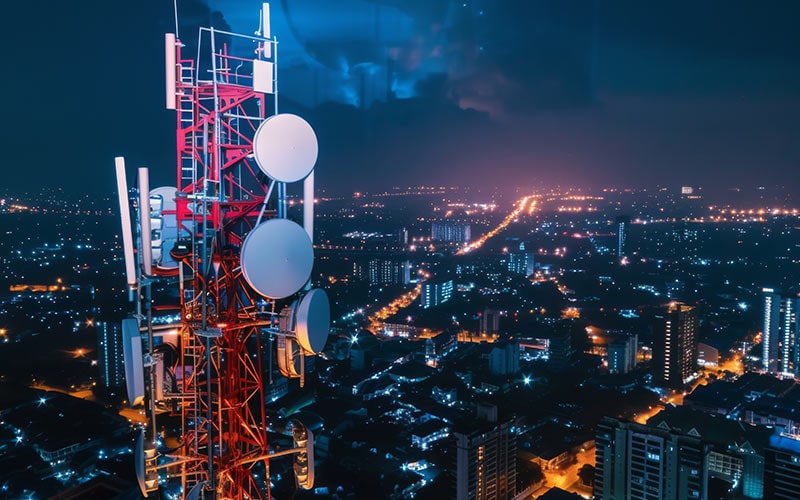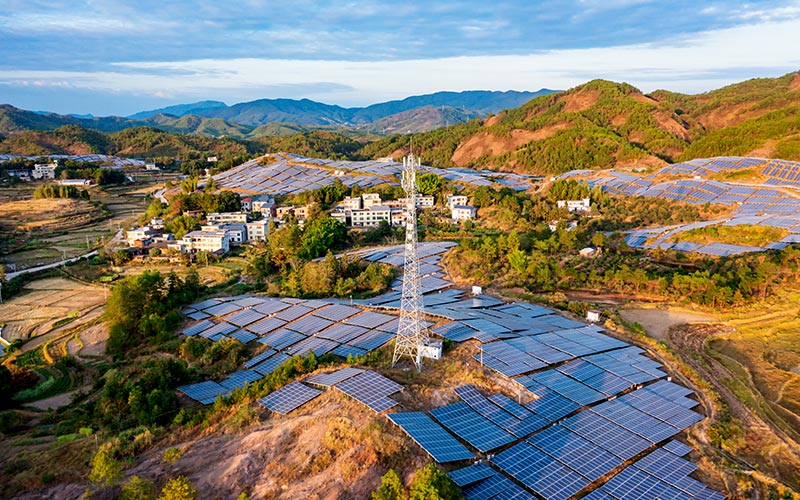A race is underway between hyperscalers and telcos to lead an edge ecosystem of 5G services. Both have their respective strengths across infrastructure, operations, and applications. But who will win?
At the edge of mobile and computer networks, a race is underway between hyperscalers and telcos. This “edge” provides faster and more reliable services by physically putting processing and storage capacity closer to the end user. Whoever builds the edge computing capabilities for 5G first will control a wide variety of services that need low latency, high security, and data mobility. The winner will be the gatekeeper for a next-generation, 5G-enabled digital ecosystem.
The edge is not new, but it is growing in value. Content delivery networks have been using edge computing to cache content and save transit costs for operators for quite some time. But with 5G up and running, new use cases are emerging that have made the edge that much more important. Competitive online gaming — known as esports — is a growing segment of the $138 billion video game industry1 where a millisecond delay can lead to a loss. Using gaming as a service (GaaS), 5G and edge will support the ultralow latency throughput necessary for gaming aficionados in augmented reality (AR)/virtual reality (VR) environments. In smart cities, edge systems can process data collected from devices, including smart cameras and drones, to allow leaders to respond more quickly to traffic, emergencies, or other unexpected changes. In the case of smart factories, edge can be an enabler for data privacy and security by keeping the data within the bounds of the factory, in addition to reducing latency. In total, the cash to be made across industries is vast. By 2023, 5G and edge will provide $517 billion of revenue across industrial manufacturing, connected health care, intelligent transportation, environmental monitoring, and gaming alone.2
But who will get there first and control this ecosystem? Both the hyperscalers — global cloud businesses — and telcos are well positioned to win this race. For telcos, winning creates the opportunity to go beyond their image as a mere connectivity provider. In order to win, they must provide enterprises and end customers with desirable applications sitting on top of highly programmable and automated networks.
Hyperscalers are moving forward quickly
Hyperscalers grew from cash-rich organizations such as Alphabet, Amazon, and Microsoft. They are leading in artificial intelligence (AI) and automation, and have the global scale to achieve humongous operational efficiencies. As far as global connectivity goes, they have been instrumental in laying down strategic intercontinental undersea cables. In fact, Google and other internet companies were behind four-fifths of transatlantic cable investment in the past two years.3
These hyperscalers, confident and hungry, are aiming to use edge computing to power numerous AI and 5G services. Microsoft launched Azure Edge Zones in March — an edge play where latency-sensitive and throughput-intensive applications can be run close to end users.4 They also bought two edge platform providers in the first half of 2020 — Affirmed Networks in March5 and Metaswitch Networks in May6 — in a bid to move closer to the source of data. To do more and get closer to the gatekeeper role, hyperscalers need government licenses and approvals for last-mile connectivity, which is not their core business. One way around this is to join hands with local telcos, something many hyperscalers are now considering. In July 2020, Glenn Gore, director of solutions architecture at Amazon Web Services (AWS), told Light Reading that it aimed to be a partner to the telecommunications industry, not its replacement.7
Telcos moving up the value chain for 5G and edge
Telcos have a strong track record of network innovations. They were instrumental in the evolution of 2G (voice and SMS), 3G (mobile internet), and 4G (video). But a lot has been placed on their shoulders. Tough government restrictions on the use of the spectrum are just one example. Regulations on network equipment and customer quality of service are another two. Many would argue that this has just made them better. They also own assets right up to the last mile and have vast experience in network operations. This expertise was highlighted this year. Even as network traffic growth eclipsed 30% in March due to COVID-19, most people could use the internet.8 But as in any hero story, the antagonist is never far away. Telcos are under severe pressure due to increasing costs and a flat five-year revenue forecast. In fact, if one source is to be believed, telco revenue will grow at just 1% year on year to 2025.9
Telcos of differing sizes and structures are pursuing different paths to reach the edge and become a gatekeeper. Smaller telcos are considering partnerships with hyperscalers as a strategy for managing costs. They argue that they don’t have the human or financial capital to compete and will do better to just hold tight to those that do. In this way, they aim to finish the race second, without completely giving up their margins. On the other side, leading telcos are strengthening their capabilities to go it alone, win the race, and make more money. Bigger telco giants are coming together in clubs such as the 5G Future Forum and Global System for Mobile Communications (GSMA) to explore ways they can partner and drive the 5G and edge ecosystem while defining the role hyperscalers will play in their business model. The implication here is that both telcos and hyperscalers can play a role in gatekeeping a new generation of digital applications.
The edge in focus: infra, ops, and apps
Examining the main aspects of the edge — infrastructure, operations, and applications — will shed more light on how hyperscalers and telcos can gain ground in their race.
Telcos are good at infrastructure, making this part of the race easier for them. Edge servers — supplied by either a third party or a hyperscaler — can be housed along with other site infrastructure and associated equipment, including the racks, cabinets, and power, that are needed to make the edge work. They also own the telco-grade backhaul and fiber, which is imperative if edge is to comply with stringent service-level agreements with their customers. Large tower companies — businesses that rent tower space to mobile carriers — are also active in pursuing new revenue streams on the infrastructure side.
Telcos also have extensive experience in operations and the understanding to manage vast networks that provide essential services. Historically, this area involved large teams with a high dependency on niche tools. More recently, operations have grown more automated, with network as a service and “zero-touch operations” making their way into telco vernacular. On the other side, hyperscalers’ experience and aptitude with automation have allowed them to quickly develop advanced and efficient operational capabilities.
The applications aspect of the cloud edge would not be possible without infra and ops, but this is where the race will truly be decided. Applications are all the use cases that will work over the edge, such as our gaming example or an application for a private industrial network. The winning gatekeepers will achieve the full benefit of the ecosystem, first by monetizing the services and then by selling the data they generate to third parties, including application developers. The apps mainly come from new developers, startups, or established application development software companies. Both telcos and hyperscalers are trying to build an all-encompassing marketplace for these applications, often by conducting events, hackathons, and competitions. Savvy telcos can offer alternative applications and solutions for enterprises, and they also can leverage the native capabilities of hyperscalers, such as their AI engines or data lakes for their own edge efforts.
Conversely, some hyperscalers consider the telcos themselves as a main driver for their cloud/edge business. In fact, this strategy is already being played out. Amazon has employed AWS computing and storage services in Verizon’s data centers in Boston and the San Francisco Bay area, all at service access points on the edge of the 5G network. These “AWS Wavelength” zones mean that data never has to leave Amazon’s network.10 Amazon is using the same strategy across Europe, Japan, and South Korea, deploying edge servers in Vodafone’s (U.K. and Germany), SK Telecom’s, and KDDI’s networks.11
Along with its acquisition of Affirmed Networks and Metaswitch, Microsoft has also formed partnerships with major telcos, including AT&T, CenturyLink, and SK Telecom.12 As recently as August, AWS moved into India, partnering with Indian telco conglomerate Bharti Airtel to deliver edge computing to enterprises.13 Google, Facebook, and others have invested in Reliance Jio, another Indian telco, in order to reach the growing number of internet users in India. These partnerships will give the hyperscalers added reach in the Indian edge ecosystem, while the Indian telco will see more growth in its non-wireless business, including IoT and Jio’s app suite.14
A race with room for competition and collaboration
From a customer perspective, the best result in this race to the edge would be for both players to finish the race together and each take a slice of the ecosystem. Telcos and hyperscalers working in concert would spawn growth across the global digital market. Telcos should provide orchestration capabilities (their forte) while offering flexibility of choice to customers. In this paradigm, automation and network as a service will play a starring role. The hyperscalers, which have made critical inroads in enterprise data ingestion, security, business analytics, and AI, can help telcos build an ecosystem of innovative applications, all offered from the same storefront.
But telcos should retain a competitive spirit while collaborating. Initiatives such as AWS Wavelength do much for the hyperscaler, but less for its partner. For instance, Varjo, a high-end VR company, uses AWS Wavelength for ultralow latency processing and rendering in Amazon’s public cloud.15 Amazon gets to keep all the data, which it can use to train lucrative AI/machine learning models. For many telcos, it doesn’t have to be this way. Enterprise customers, for one, may not want to go all in on one hyperscaler’s services. Many end customers would prefer a range of choices so that they can compare prices and choose packages tailored to their specific needs. This is where leading telcos can offer a well-orchestrated multicloud capability across numerous use cases, along with a telco-grade experience of end-to-end services. This will require work, but by wresting tight control of the application and developer ecosystem and by using some capabilities offered by hyperscalers, it’s possible. Smaller players may choose to simply provide connectivity, however, and let the hyperscalers do the heavy lifting. In doing so, they will still get hold of the hyperscalers’ next-generation capabilities and have ready access to a global marketplace of applications.
Telcos and hyperscalers both must work hard now to bring the most innovative solutions to market in the most economical ways possible. In doing so, they will benefit a wide range of customers. This is possible only if they work together closely in the next five years, using their respective strengths to drive global adoption of 5G/edge services, increase operational efficiencies, and make lots of cash.
References
- Mobile Revenues Account for More Than 50% of the Global Games Market as It Reaches $137.9 Billion in 2018, Tom Wijman, April 30, 2018, Newzoo.com.
- The 5G edge computing value opportunity, June 2020, KPMG.
- The Undersea Cable Market Is Booming Again, This Time Funded by Big Tech, Thomas Seal, March 14, 2019, Bloomberg Businessweek.
- Microsoft partners with the industry to unlock new 5G scenarios with Azure Edge Zones, Yousef Khalidi, March 31, 2020, Microsoft Azure.
- Microsoft announces agreement to acquire Affirmed Networks to deliver new opportunities for a global 5G ecosystem, Yousef Khalidi, March 26, 2020, Microsoft.
- Microsoft announces definitive agreement to acquire Metaswitch Networks, expanding approach to empower operators and partner with network equipment providers to deliver on promise of 5G, Yousef Khalidi, May 14, 2020, Microsoft.
- Amazon Web Services answers the question: Friend or foe to telcos?, Mike Dano, July 16, 2020, Light Reading.
- Network traffic insights in the time of COVID-19: June 4 update, Craig Labovitz, June 9, 2020, Nokia.
- The Mobile Economy 2020, GSMA Intelligence.
- Verizon and AWS deliver mobile edge computing to customers in Boston and Bay Area, Matt Garman & Tami Erwin, Aug. 6, 2020, AWS.
- Announcing AWS Wavelength for delivering ultra-low latency applications for 5G, Dec 3, 2019, AWS.
- How Amazon, Microsoft and Google are courting — and challenging — telcos, Sue Marek, April 6, 2020, Light Reading.
- Why India has become a key battleground for Amazon and Microsoft, Arjun Srinivas, Aug. 11, 2020, Live Mint.
- Google in talks to invest $4 billion in Jio Platforms, July 15, 2020, ET Telecom.
- Varjo chosen as Amazon Web Services partner for AWS Wavelength, Dec. 12, 2019, Auganix.





